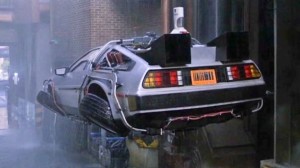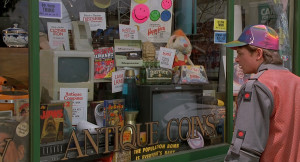"Back to the Future" is Now
What enormous year-end event could possibly cause media ranging from CNN, the BBC, Newsweek, and NPR to The Globe and Mail and Mental Floss to call the Practical Futurist for an interview?
Try the 1989 movie “Back to the Future 2”--which happens to be set in 2015 and is thus full of predictions for our upcoming year.
 The reporters were particularly interested in what the film got wrong, which includes both Doc’s flying car and Marty McFly’s hoverboard. Of course futurists have been getting the flying car wrong since at least 1957, when Popular Mechanics featured a flying car on the cover. They cautioned in the article, however, that we wouldn’t actually have them until 1967.
The reporters were particularly interested in what the film got wrong, which includes both Doc’s flying car and Marty McFly’s hoverboard. Of course futurists have been getting the flying car wrong since at least 1957, when Popular Mechanics featured a flying car on the cover. They cautioned in the article, however, that we wouldn’t actually have them until 1967.
And the hoverboard? Entrepreneurs have lately come up with a version, but it functions magnetically and thus only floats above metal surfaces. Marty’s hoverboard, on the other hand, floats over anything and the only way I can imagine it might work is anti-gravity. Alas, in 2015, it’s unlikely we’ll even have a complete theory of gravity.
On the other hand, BTTF2 got some things right: Marty uses a thumbprint to pay for a taxi ride (shades of the iPhone 6); TV screens are flat and wall-sized; video telephone calls are increasingly common.
Of course, BTTF2 wasn’t meant to be a futurist manifesto but rather an entertaining movie. And it certainly succeeded at being memorable, considering the number of journalists who are writing about it 26 years later. (We’ll see how many articles appear at the end of 2018 about “Bladerunner”, which was set in 2019.)
 But it’s also a good reminder of the difference between futurism and science fiction. New technologies can run into all sorts of financial, governmental and social problems that the fiction writer can happily ignore. For example: even if you could build a reasonably-priced flying car, you’d need new infrastructure for landing, a whole new range of driver skills and the approval of government agencies from the Department of Transportation to the FAA.
But it’s also a good reminder of the difference between futurism and science fiction. New technologies can run into all sorts of financial, governmental and social problems that the fiction writer can happily ignore. For example: even if you could build a reasonably-priced flying car, you’d need new infrastructure for landing, a whole new range of driver skills and the approval of government agencies from the Department of Transportation to the FAA.
And thus a good futurist needs to understand not just technology, but the worlds of business, government, and human nature.
Human nature was one thing that BTTF2 got right. My favorite prediction was that objects from the 70s and 80s would become sought-after antiques in 2015. Sure enough, a couple of weeks ago, an Apple I from the mid-’70s sold at auction for $360,000. Don’t ditch that 1984 Mac quite yet!

